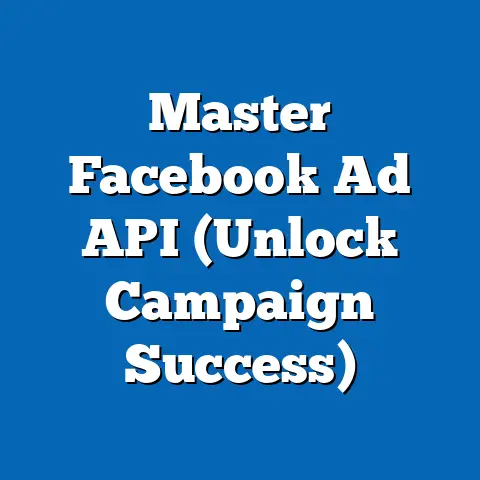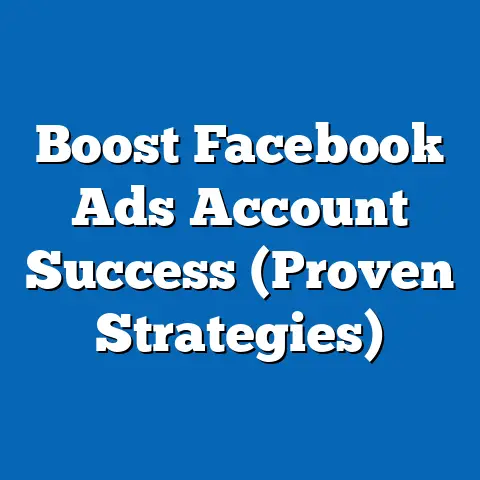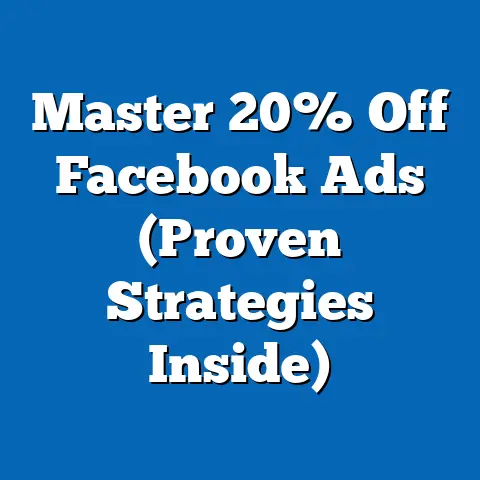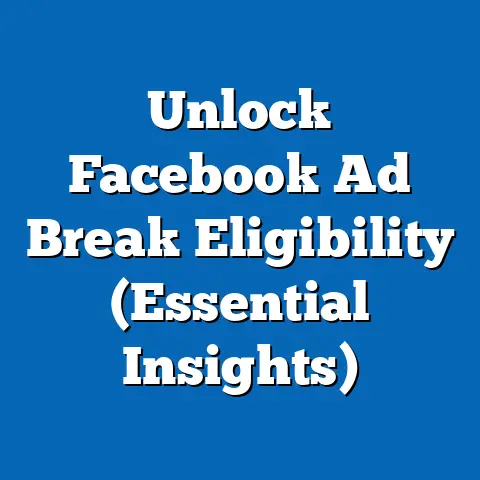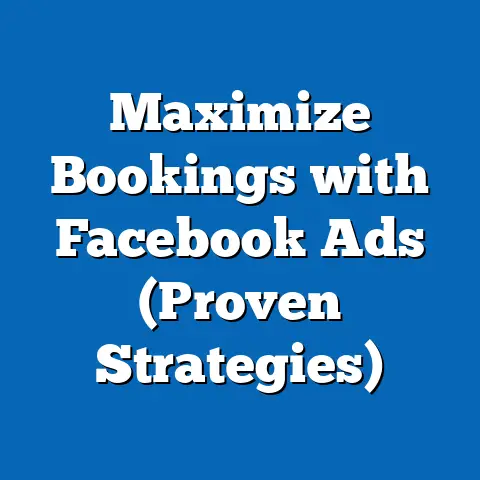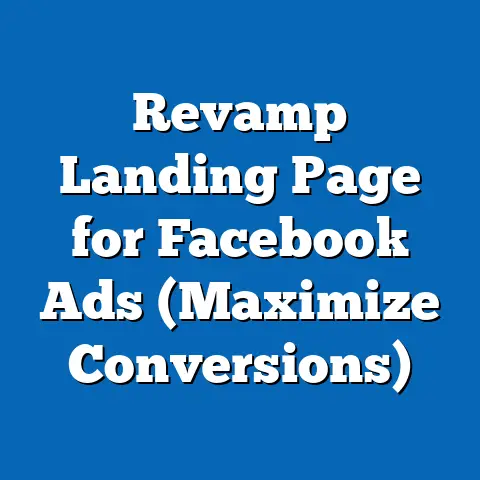Editing Facebook Ads: Is It Worth the Risk? (Expert Insights)
Have you ever launched a Facebook ad campaign, watched it chug along, and thought, “There has to be a way to make this perform better?” I know I have. The world of Facebook advertising is a constantly evolving landscape, and sometimes, the key to unlocking success lies in the art of editing. We’re not just talking about fixing typos here; we’re talking about strategically tweaking your ads to resonate more deeply with your audience, drive down costs, and ultimately, boost your ROI.
Think of it this way: your initial ad is like a first draft. It’s a good starting point, but it rarely captures the full potential of your message. Fine-tuning your ad copy, swapping out visuals, or even refining your targeting can lead to dramatic improvements. I’ve personally seen campaigns jump from a mediocre 1% conversion rate to a stellar 5% just by making a few carefully considered edits.
But here’s the catch: editing Facebook ads isn’t a guaranteed win. There’s a delicate balance to strike. Make too many changes, or make them too frequently, and you risk disrupting the algorithm, losing valuable data, and ultimately, hurting your performance. It’s a bit like performing surgery – precision and knowledge are crucial.
1: The Importance of Facebook Ads in Digital Marketing
Facebook, or Meta as it’s now known, remains a titan in the digital advertising arena. Ignoring its potential is like leaving money on the table. I’ve been in digital marketing long enough to see platforms come and go, but Facebook has proven its staying power, constantly adapting and innovating to stay relevant.
Let’s look at the numbers. As of early 2024, Facebook boasts nearly 3 billion monthly active users. That’s a staggering reach, representing a significant portion of the global population. More importantly for us marketers, these users aren’t just passively scrolling; they’re actively engaging with content, discovering new products, and connecting with brands.
This massive user base translates directly into advertising reach. Facebook offers unparalleled targeting capabilities, allowing you to pinpoint your ideal customer based on demographics, interests, behaviors, and even custom audiences built from your existing customer data. I remember one campaign where we used Facebook’s lookalike audience feature to target users who shared similar characteristics with our top-spending customers. The results were phenomenal, with a 3x increase in conversion rates compared to our previous broad targeting efforts.
Businesses leverage Facebook ads for a multitude of purposes:
- Brand Awareness: Building recognition and familiarity with your brand among a wide audience.
- Lead Generation: Capturing contact information from potential customers interested in your products or services.
- Sales: Driving direct sales through targeted ads that showcase your offerings and encourage immediate purchase.
The beauty of Facebook advertising lies in its versatility. Whether you’re a small local business or a large multinational corporation, Facebook offers a suite of ad formats and targeting options to suit your specific goals and budget.
Speaking of ad formats, let’s briefly touch on some of the most popular options:
- Image Ads: Simple yet effective, image ads are perfect for showcasing your product or service with a compelling visual.
- Video Ads: Engaging and attention-grabbing, video ads allow you to tell your brand story and demonstrate your product in action.
- Carousel Ads: Displaying multiple images or videos in a single ad unit, carousel ads are ideal for showcasing a range of products or features.
- Collection Ads: Designed for e-commerce businesses, collection ads create a visually immersive shopping experience, allowing users to browse and purchase products directly from the ad.
- Lead Ads: Capture leads directly within Facebook, making it easy for users to provide their contact information without leaving the platform.
Each ad format has its unique advantages, and the best choice will depend on your specific goals and target audience. As a rule of thumb, I always recommend testing different formats to see what resonates best with your audience.
Key Takeaway: Facebook advertising remains a powerful tool for businesses of all sizes, offering unparalleled reach, targeting capabilities, and a diverse range of ad formats. Understanding the importance of Facebook ads in the broader digital marketing landscape is the first step towards unlocking its potential for your business.
2: Understanding the Editing Process
Now that we’ve established the importance of Facebook ads, let’s delve into the nitty-gritty of the editing process. What exactly does it mean to edit a Facebook ad, and how do you go about it?
Editing Facebook ads essentially involves making changes to any element of your existing ad campaign, ad set, or individual ad. This can include:
- Copy Tweaks: Refining your ad headline, body text, or call-to-action to improve clarity, relevance, and persuasiveness.
- Visual Changes: Swapping out images or videos to test different creative approaches and capture your audience’s attention.
- Audience Targeting Adjustments: Refining your targeting criteria to reach a more specific and relevant audience.
- Budget Modifications: Increasing or decreasing your daily or lifetime budget based on performance.
- Placement Optimization: Adjusting where your ads are displayed (e.g., Facebook feed, Instagram feed, Audience Network) to maximize reach and engagement.
It’s important to distinguish between minor edits and major overhauls. A minor edit might involve tweaking a headline or adjusting a budget, while a major overhaul could involve completely rewriting your ad copy, replacing your visuals, and redefining your target audience. The approach you take will depend on the specific issues you’re trying to address and the data you have available.
Facebook provides a robust set of tools and resources for editing your ads, primarily through the Facebook Ads Manager. This is your central hub for managing all aspects of your Facebook advertising campaigns.
Within the Ads Manager, you can:
- Access Your Campaigns, Ad Sets, and Ads: Easily navigate through your advertising structure to locate the specific element you want to edit.
- Make Real-Time Changes: Edit your ad copy, visuals, targeting, and budget directly within the Ads Manager interface.
- Track Performance Metrics: Monitor key performance indicators (KPIs) such as reach, impressions, clicks, conversions, and cost-per-click to assess the impact of your edits.
- A/B Test Different Variations: Create multiple versions of your ads to test different copy, visuals, and targeting options, allowing you to identify the most effective combinations.
Beyond the Ads Manager, there are also a variety of third-party analytics tools that can provide deeper insights into your ad performance and help you identify areas for improvement. Tools like Hootsuite, Sprout Social, and Google Analytics can offer valuable data on user behavior, website traffic, and conversion rates, helping you make more informed decisions about your ad edits.
Now, let’s talk about best practices. Editing Facebook ads shouldn’t be a haphazard process. It should be driven by data and guided by a clear understanding of your goals and target audience. Here’s my approach:
- Analyze Your Data: Before making any edits, take a close look at your ad performance data. Identify areas where your ads are underperforming, such as low click-through rates, high cost-per-click, or low conversion rates.
- Formulate a Hypothesis: Based on your data analysis, develop a hypothesis about why your ads are underperforming and what changes you can make to improve them. For example, you might hypothesize that your ad copy is too generic and that a more specific and compelling headline would improve click-through rates.
- Implement Your Edits: Make the necessary changes to your ad, focusing on the elements that you believe will have the biggest impact.
- Monitor Your Results: Closely track your ad performance after making your edits to see if they have had the desired effect. Be patient – it may take some time for the algorithm to adjust and for the full impact of your edits to become clear.
- Iterate and Optimize: If your edits don’t produce the desired results, don’t be afraid to iterate and try different approaches. The key is to continuously test and optimize your ads based on data and feedback.
One of the most powerful tools in your arsenal is A/B testing. This involves creating multiple versions of your ad with slight variations and then testing them against each other to see which performs best. For example, you might test two different headlines, two different images, or two different call-to-actions. A/B testing allows you to make data-driven decisions about your ad edits, ensuring that you’re always moving in the right direction.
Key Takeaway: Understanding the editing process is crucial for optimizing your Facebook ad campaigns. By leveraging the tools and resources available, analyzing your data, and implementing a systematic approach to testing and optimization, you can unlock the full potential of your ads and drive better results.
3: The Benefits of Editing Facebook Ads
We’ve touched on the potential benefits of editing Facebook ads, but let’s dive deeper and explore these advantages in more detail. I’ve seen firsthand how strategic edits can transform a struggling campaign into a roaring success.
One of the most significant benefits of editing is enhanced targeting precision. Your initial targeting may have been based on assumptions or broad demographics, but as your campaign runs, you’ll gather valuable data about who is actually engaging with your ads. This data allows you to refine your targeting criteria and reach a more specific and relevant audience.
For example, let’s say you’re running an ad campaign for a new line of vegan protein powder. Your initial targeting might have included people interested in “fitness,” “nutrition,” and “veganism.” However, after analyzing your data, you discover that a significant portion of your conversions are coming from people interested in “yoga” and “plant-based diets.” Armed with this information, you can refine your targeting to focus on these more specific interests, potentially leading to a higher conversion rate and a lower cost-per-acquisition.
Another key benefit is improved ad relevance. Facebook’s algorithm prioritizes ads that are relevant to the user, rewarding them with higher placement and lower costs. By editing your ad copy, visuals, and targeting to better align with your audience’s preferences, you can improve your ad relevance score and boost your performance.
I remember one campaign where we were struggling with a low relevance score. After conducting some research, we discovered that our target audience was particularly interested in sustainability. We edited our ad copy to highlight the eco-friendly aspects of our product and replaced our visuals with images that showcased our commitment to environmental responsibility. The result? Our relevance score skyrocketed, and our cost-per-click dropped dramatically.
Editing also allows you to achieve better alignment with audience preferences. Consumer preferences are constantly evolving, and what worked yesterday may not work today. By continuously monitoring your ad performance and staying attuned to the latest trends, you can adapt your ads to resonate more effectively with your audience.
For instance, let’s say you’re running an ad campaign for a mobile app. Initially, you focused on highlighting the app’s core features and functionality. However, after observing user reviews and social media conversations, you realize that your audience is more interested in the app’s ability to improve productivity and reduce stress. You can then edit your ad copy and visuals to focus on these benefits, potentially attracting a wider audience and driving more downloads.
Here are a few real-life examples of businesses that successfully edited their ads to achieve desired outcomes:
- A local restaurant: Initially, they ran a generic ad showcasing their menu items. After analyzing their data, they discovered that their target audience was particularly interested in their weekly specials. They edited their ad copy to highlight these specials and saw a significant increase in foot traffic.
- An e-commerce store: They were struggling with a high cart abandonment rate. After conducting a survey, they discovered that their customers were concerned about shipping costs. They edited their ad copy to offer free shipping on orders over a certain amount and saw a significant decrease in cart abandonment.
- A SaaS company: They were running an ad campaign to generate leads for their software. After analyzing their data, they discovered that their target audience was more responsive to video ads than image ads. They created a short video demonstrating the key features of their software and saw a significant increase in lead generation.
These examples illustrate the power of continuous optimization. Editing Facebook ads isn’t a one-time task; it’s an ongoing process of testing, learning, and adapting to your audience’s needs and preferences.
To further emphasize the value of continuous optimization, I spoke with Sarah Jones, a seasoned Facebook advertising expert with over 10 years of experience. “In today’s competitive landscape,” Sarah explained, “you can’t afford to set it and forget it. You need to be constantly monitoring your ad performance, identifying areas for improvement, and making strategic edits to stay ahead of the curve. The businesses that embrace this approach are the ones that consistently see the best results.”
Key Takeaway: Editing Facebook ads offers a multitude of benefits, including enhanced targeting precision, improved ad relevance, and better alignment with audience preferences. By embracing a continuous optimization mindset and leveraging data-driven insights, you can unlock the full potential of your ad campaigns and drive better results.
4: The Risks Associated with Editing Facebook Ads
While the benefits of editing Facebook ads are undeniable, it’s crucial to acknowledge the potential downsides and risks. As I mentioned earlier, editing isn’t always a guaranteed win. There are situations where it might be more beneficial to leave an ad as is rather than tinkering with it.
One of the biggest risks is the possibility of losing established performance metrics. When you edit an ad, Facebook essentially resets its learning phase. The algorithm needs time to re-evaluate your ad and determine its optimal placement and targeting. During this learning phase, your ad performance may fluctuate, and you may see a temporary dip in results.
I’ve experienced this firsthand on several occasions. I remember one campaign where we were running a highly successful ad with a low cost-per-conversion. We decided to make a minor tweak to the headline, thinking it would further improve performance. However, after making the edit, our cost-per-conversion actually increased, and it took several days for the algorithm to re-optimize and bring our results back to their previous level.
Another risk is the implication of making frequent changes to ad sets. Facebook’s algorithm relies on historical data to optimize your ad delivery. Making too many changes to your ad sets can disrupt this process and make it harder for the algorithm to learn and adapt. This can lead to unstable performance and unpredictable results.
Moreover, editing can affect Facebook’s algorithm. The algorithm is designed to reward ads that are stable and consistent. If you’re constantly changing your ads, the algorithm may perceive them as unreliable and penalize them with lower placement and higher costs.
So, when might it be more beneficial to leave an ad as is rather than editing it?
- When Your Ad is Already Performing Well: If your ad is achieving your desired results, there’s often no need to mess with it. As the saying goes, “If it ain’t broke, don’t fix it.”
- When You Don’t Have Enough Data: Making edits based on insufficient data can be counterproductive. Wait until you have a statistically significant sample size before making any major changes.
- When You’re Unsure About the Impact of Your Edits: If you’re not confident that your edits will improve performance, it’s often better to err on the side of caution and leave the ad as is.
I reached out to David Lee, a Facebook advertising consultant with extensive experience in managing large-scale campaigns, to get his perspective on this issue. “The key is to be strategic and deliberate with your edits,” David advised. “Don’t make changes just for the sake of making changes. Always have a clear hypothesis about why you’re making the edit and what impact you expect it to have. And be prepared to monitor your results closely and adjust your approach if necessary.”
David also emphasized the importance of understanding Facebook’s algorithm. “The algorithm is constantly evolving,” he explained. “It’s important to stay up-to-date on the latest changes and best practices to ensure that your edits are aligned with the algorithm’s goals.”
Key Takeaway: While editing Facebook ads can be a powerful tool for optimization, it’s crucial to be aware of the potential risks. By understanding the implications of your edits and adopting a strategic and data-driven approach, you can minimize these risks and maximize your chances of success.
5: Case Studies: Success and Failure Stories
To further illustrate the nuances of editing Facebook ads, let’s examine a few real-world case studies. These examples will showcase both successful and unsuccessful ad edits, providing valuable lessons learned from both triumphs and failures.
Case Study 1: The E-commerce Brand That Doubled Its Conversion Rate
An e-commerce brand selling handmade jewelry was running a Facebook ad campaign targeting women aged 25-45 interested in fashion and accessories. Their initial ad featured a generic image of their products and a standard call-to-action: “Shop Now.”
After analyzing their data, they discovered that their click-through rate was relatively low, and their conversion rate was even lower. They hypothesized that their ad copy and visuals weren’t resonating with their target audience.
They decided to make the following edits:
- Ad Copy: They rewrote their ad copy to focus on the unique craftsmanship and artistry of their jewelry. They also included customer testimonials highlighting the quality and beauty of their products.
- Visuals: They replaced the generic product image with a lifestyle shot featuring a woman wearing their jewelry in a stylish and aspirational setting.
- Call-to-Action: They changed their call-to-action from “Shop Now” to “Discover Your Perfect Piece.”
The results were dramatic. Their click-through rate increased by 50%, and their conversion rate doubled. By making these strategic edits, they were able to better connect with their target audience and drive significantly more sales.
Lesson Learned: Emphasize the unique value proposition of your product or service in your ad copy and visuals. Use lifestyle shots to showcase your products in action and appeal to your target audience’s aspirations.
Case Study 2: The Local Restaurant That Lost Its Momentum
A local restaurant was running a Facebook ad campaign to promote their lunch specials. Their initial ad was performing well, driving a steady stream of customers to their restaurant.
However, they decided to make a seemingly minor edit: they changed the image in their ad to feature a different lunch special. They didn’t change anything else – the ad copy, targeting, and budget remained the same.
To their surprise, their ad performance plummeted. Their click-through rate decreased, and their cost-per-click increased. They couldn’t figure out why.
After further investigation, they realized that the original image in their ad was particularly appealing to their target audience. It featured a popular dish that was well-known and loved by their customers. By changing the image, they inadvertently removed the element that was driving their success.
Lesson Learned: If your ad is already performing well, be cautious about making changes, even seemingly minor ones. Sometimes, the best approach is to leave well enough alone.
Case Study 3: The SaaS Company That A/B Tested Its Way to Success
A SaaS company was running a Facebook ad campaign to generate leads for their software. They were struggling with a low conversion rate and decided to implement A/B testing to optimize their ad performance.
They created two versions of their ad:
- Ad A: Featured a headline that focused on the software’s core features.
- Ad B: Featured a headline that focused on the software’s benefits and how it could solve their target audience’s problems.
They then paused Ad A and continued running Ad B, which continued to drive strong results.
Lesson Learned: A/B testing is a powerful tool for optimizing your Facebook ad campaigns. By testing different variations of your ad, you can identify the most effective combinations and drive better results.
These case studies highlight the importance of a strategic and data-driven approach to editing Facebook ads. By understanding the potential benefits and risks, analyzing your data, and implementing a systematic approach to testing and optimization, you can increase your chances of success and avoid costly mistakes.
Key Takeaway: Case studies provide valuable insights into the nuances of editing Facebook ads. By learning from the successes and failures of others, you can develop a more informed and effective approach to optimizing your own ad campaigns.
Conclusion
So, is editing Facebook ads worth the risk? The answer, as with most things in digital marketing, is “it depends.” There’s no one-size-fits-all solution. The key lies in understanding the potential benefits and risks, analyzing your data, and adopting a strategic and data-driven approach.
Editing can be a powerful tool for optimization, allowing you to enhance targeting precision, improve ad relevance, and better align with audience preferences. However, it’s crucial to be aware of the potential downsides, such as the possibility of losing established performance metrics or disrupting Facebook’s algorithm.
Ultimately, the decision of whether or not to edit your Facebook ads should be based on your unique circumstances and goals. Weigh the potential benefits against the potential risks and make an informed decision based on your data and expertise.
As I mentioned at the beginning of this guide, the world of Facebook advertising is constantly evolving. New features are introduced, algorithms change, and consumer preferences shift. To stay ahead of the curve, you need to be adaptable, curious, and committed to continuous learning.
Embrace the challenge, experiment with different approaches, and never stop optimizing. The rewards are well worth the effort. By mastering the art of editing Facebook ads, you can unlock the full potential of your campaigns and drive significant results for your business.
Remember, the best marketers are not afraid to experiment, to learn from their mistakes, and to adapt to the ever-changing landscape of digital advertising. So, go forth, edit with confidence, and watch your Facebook ad campaigns soar!

